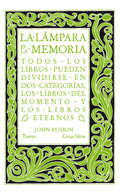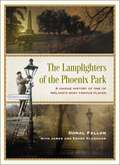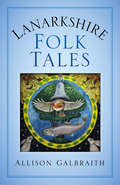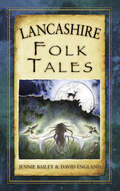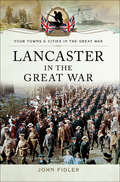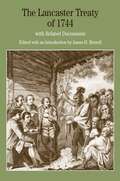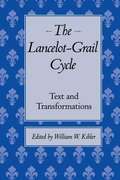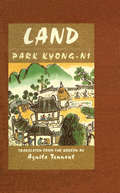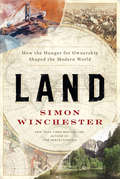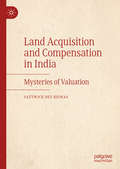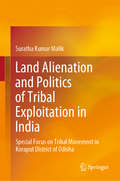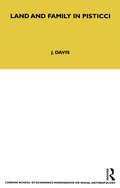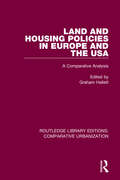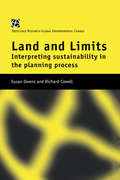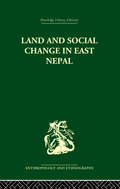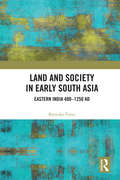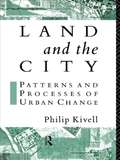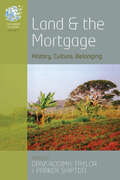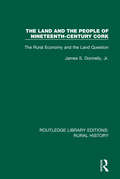- Table View
- List View
The Lamentations: A Requiem for Queer Suicide
by Patrick AndersonFINALIST, ASSOCIATION FOR THEATRE IN HIGHER EDUCATION (ATHE) OUTSTANDING BOOK AWARDA moving journey through the shadows of queer suicide and a tribute to lives marked by struggle and beautyThe Lamentations explores the struggles and resilience within the queer community, offering a unique blend of historical analysis and emotional tribute to those affected. Author Patrick Anderson examines the phenomenon of queer suicide across various art forms such as film, theatre, and literature, tracing its evolution from the twentieth century to today.Anderson brings to light the personal stories of individuals in the queer community who have ended their lives, compiling narratives from sources like newspaper articles, obituaries, and case studies. The book confronts the harsh realities of loneliness, shame, and oppression faced by many LGBTQ+ individuals, providing a poignant reflection on the societal challenges they face.The Lamentations is more than a meditation on death; it’s a narrative of survival, mourning, and healing. Sharing personal accounts, including the losses of loved ones and friends, Anderson highlights the importance of memory and storytelling in celebrating the vibrancy of queer life amidst the sorrow of loss. Accessible to a broad readership, the book transcends academic boundaries to address themes of love, loss, and the human spirit. It’s a compelling read for anyone interested in queer studies or anyone seeking to understand human experience through the lens of loss and legacy.
La lámpara de la memoria (Serie Great Ideas #Volumen 33)
by John RuskinIdeas que han cambiado el mundo A lo largo de la historia, algunos libros han cambiado el mundo. <P><P>Han transformado la manera en que nos vemos a nosotros mismos y a los demás. Han inspirado el debate, la discordia, la guerra y la revolución. Han iluminado, indignado, provocado y consolado. Han enriquecido vidas, y también las han destruido. Taurus publica las obras de los grandes pensadores, pioneros, radicales y visionarios cuyas ideas sacudieron la civilización y nos impulsaron a ser quienes somos. <P><P>John Ruskin echó abajo las ideas sobre arte y arquitectura dominantes en la sociedad victoriana. Para él, en las obras arquitectónicas, lejos del ánimo de lucro, debe primar el afán por comunicar verdades humanas eternas y transmitir la historia viva de la sociedad que las produjo.
The Lamplighters of the Phoenix Park: A unique history of one of Ireland’s most famous places
by James Flanagan Frank Flanagan Donal FallonThe Phoenix Park in Dublin holds a special place in the collective memory of Irish people. From the assassinations of 1882 and the destruction of several imperial monuments, to the arrival of Douglas Hyde as Ireland's first president and Pope John Paul's 1979 visit, it has been at the centre of Irish society for centuries.But the park is also part and parcel of daily life for many Dubliners - none more so than the Flanagan family, who have been lighting the gas lamps within its walls since 1890.Here, historian Donal Fallon speaks to brothers Frank and James Flanagan, lamplighters of the park, to give us a snapshot of a fading tradition, and a unique history of one of Ireland's most beloved places.With stunning photographs, historical events and personal stories, The Lamplighters of the Phoenix Park shines a light on the park at the centre of our national identity, through the prism of this singular family, whose histories have been intertwined for more than 150 years.
The Lamplighters of the Phoenix Park: A unique history of one of Ireland’s most famous places
by James Flanagan Frank Flanagan Donal FallonThe Phoenix Park in Dublin holds a special place in the collective memory of Irish people. From the assassinations of 1882 and the destruction of several imperial monuments, to the arrival of Douglas Hyde as Ireland's first president and Pope John Paul's 1979 visit, it has been at the centre of Irish society for centuries.But the park is also part and parcel of daily life for many Dubliners - none more so than the Flanagan family, who have been lighting the gas lamps within its walls since 1890.Here, historian Donal Fallon speaks to brothers Frank and James Flanagan, lamplighters of the park, to give us a snapshot of a fading tradition, and a unique history of one of Ireland's most beloved places.With stunning photographs, historical events and personal stories, The Lamplighters of the Phoenix Park shines a light on the park at the centre of our national identity, through the prism of this singular family, whose histories have been intertwined for more than 150 years.
Lanarkshire Folk Tales
by Allison GalbraithFrom a cantankerous brownie in Dolphinton to the vampire with iron teeth who terrorised Glasgow, this collection of tales spans fourteen centuries of Lanarkshire's history and happenings. Here you will find the legends of William Wallace's love and loss in Lanark and Saint Mungo's bitter feud with the Pagan hierarchy and Druids, alongside totemic animals, unique Scottish flora and fauna, warlocks, herb-wives and elfin trickery.Allison Galbraith combines storytelling expertise with two decades of folklore research to present this beguiling collection of Lanarkshire stories, suitable for adults and older children.
Lancashire Folk Tales (Folk Tales: United Kingdom)
by Jennie Bailey David EnglandThese lively and entertaining folk tales from one of Britain’s most diverse counties are vividly retold by writer, storyteller and poe t Jennie Bailey and storyteller, writer,psychotherapist and shamanic guide David England. Take a fantasy journey around Lancashire, the Phantom Voice at Southport, the Leprechauns of Liverpool and the famous hanging of Pendle Witches at Lancaster,to the infamous Miss Whiplash at Clitheroe. Enjoy a rich feast of local tales, a vibrant and unique mythology,where pesky boggarts, devouring dragons, villainous knights,venomous beasts and even the Devil himself stalk the land. Beautifully illustrated by local artists Jo Lowes and Adelina Pintea, these tales bring to life the landscape of the county’s narrow valleys, medieval forests and treacherous sands.
Lancaster in the Great War
by John FidlerAlthough Lancaster was the ancient County town, it had a population of only 40,000 in 1914. Of these, it is thought that some 5,000 men saw war service between 1914-18, and over 1,000 did not return. In consequence, the recruiting drives, the tribunals to consider exemption from 1916, and the ever-growing casualty lists provide the main theme for this book.Some 3,000 men had volunteered by December 1914, to join those already serving. While the depot of the Kings Own Royal Lancaster Regiment was in the town, about eighty regiments had Lancaster men in their ranks, and both the casualty lists and the awards for gallantry reflect this.The town was out of range for shelling from the sea, or aerial bombardment, but did experience an explosion at its munitions factory in 1917. Apart from this, the mayor and council endeavoured to continue with their primary duties as far as possible in running the town.
The Lancaster Treaty of 1744: With Related Documents
by James H. MerrellThe Lancaster Treaty of 1744 offers students a close look at colonial-Indian relations in North America. The treaty minutes offer some of the best historical evidence of Iroquois perspectives on colonial power and diplomacy. James Merrell uses the treaty minutes, published by Benjamin Franklin shortly after the end of the negotiations, to illuminate critical issues in the mid-eighteenth-century struggles between and among Indians and colonial empires. These issues, including competing colonial claims, land use and tenure, diplomacy, and cultural exchange, bring complex colonial worlds to life for students. Accompanying the treaty minutes are four documents by European and colonial observers who visited the Iroquois before, during, or after the treaty negotiations, shedding further light ― and some ambiguity ― on Indian-white relations in this period. A list of major figures, a chronology of events, questions for consideration, a selected bibliography, and an index further enable students’ exploration of this event.
The Lancelot-Grail Cycle: Text and Transformations
by William W. KiblerComposed in Old French between about 1220 and 1240, the Lancelot-Grail Cycle is a group of five prose romances centered on the love affair between Lancelot and Guenevere. It consists of an immense central core, the Lancelot Proper, introduced by The History of the Holy Grail and The Story of Merlin and concluded by The Quest for the Holy Grail and The Death of Arthur. <P><P> This volume brings together thirteen essays by noted scholars from the first symposium ever devoted exclusively to the Lancelot-Grail Cycle. Exploring the cycle's evolution across the literatures of medieval France, Italy, Spain, Catalonia, and England, the authors take a variety of approaches that highlight a broad range of cultural, social, historical, and political concerns and offer a comparative and interdisciplinary vision of this great romance.
Land
by ParkFirst published in 1996. Routledge is an imprint of Taylor & Francis, an informa company.
Land: How the Hunger for Ownership Shaped the Modern World
by Simon WinchesterThe author of The Professor and the Madman and The Perfectionists explores the notion of property—our proprietary relationship with the land—through human history, how it has shaped us and what it will mean for our future.Land—whether meadow or mountainside, desert or peat bog, parkland or pasture, suburb or city—is central to our existence. It quite literally underlies and underpins everything. Employing the keen intellect, insatiable curiosity, and narrative verve that are the foundations of his previous bestselling works, Simon Winchester examines what we human beings are doing—and have done—with the billions of acres that together make up the solid surface of our planet.Land: How the Hunger for Ownership Shaped the Modern World examines in depth how we acquire land, how we steward it, how and why we fight over it, and finally, how we can, and on occasion do, come to share it. Ultimately, Winchester confronts the essential question: who actually owns the world’s land—and why does it matter?
Land Acquisition and Compensation in India: Mysteries of Valuation
by Sattwick Dey BiswasThis book discusses development and land acquisitions in India and analyzes a conceptual framework based on “paradox of values” and “plural value of land.” The research links the issue of valuation to its roots in classic economic theory and to its individual perception. The project offers an insightful perspective on current challenges of urbanization and development in the Global South, where land use regimes are in a highly dynamic transition to allow for urban amenities, housing and industrial land. The author concludes with a derived scheme or framework that addresses various potentials to better address values of land during land acquisition. It is an ideal book for anyone interested in land markets, land appraisal and land economics and land acquisition in the Global South.
Land Alienation and Politics of Tribal Exploitation in India: Special Focus on Tribal Movement in Koraput District of Odisha
by Suratha Kumar MalikThis book explores tribal land alienation problems in India and tribal agitation against land encroachment and alienation. It discusses India’s tribal land problem and explains how despite legislation to protect tribal lands, the problem has not been resolved since neither the letter nor the spirit of the law has been implemented. Due to continuous land encroachment and alienation by outsiders, the negligence of the revenue administration and the apathy of the central and state government, the situation concerning tribal land in the country have became precarious. In this context, the book highlights the process of land estrangement among the tribes and the related movements, focusing on the Narayanpatna land movement in the Koraput district of Odisha. It argues that land remains a central issue that is extremely important for tribes as it directly affects their life, livelihood, freedom and development, and that the cultural attachment of tribes and their views regarding the idea of ‘place’ (land) furnishes crucial perspectives in understanding the politics of collective resistance. It also discusses the politicization of group identity and material interest against the outside authority as the basis of the unrest among the tribes, and when the grudges of the people are hardened due to insensitivity and tyranny, the extent of tribal resistance escalates, leading to conflict between the state and its own people. Given its scope, this book is a valuable resource for students and research scholars, as well as for policymakers and anyone interested in Indian democracy and development in general, and tribal problems, issues and politics in particular.
Land and Family in Pisticci (London School Of Economics Monographs On Social Anthropology Ser.)
by J. DavisThe study of family and inheritance systems is a traditionally anthropological one. Dr Davis has examined a South Italian town with records from 1814 and concludes that the present 'typical' European system is of recent adoption, a response to the gradual and peculiar integration of Pisticci into a nation-state and national economy. The account of landholding distinguishes carefully between legal rights and informal cessions of land, and agriculture is put into the context of other economic activities. Dr Davis emphasises the structural importance of kin, family and neighbourhood relationships as bases for the creation of more ephemeral ties of friendship, clientage and network.
Land and Housing Policies in Europe and the USA: A Comparative Analysis
by Graham HallettOriginally published in 1988, this book concentrates on urban land policy and was particularly significant when it was originally published because the 1980s were an era when the rich were getting richer and the poor poorer and in which changes in the ownership of and access to real estate contributed to this polarisation. The book focusses on some core topics, namely: The buying, selling and holding of land by public agencies; the land market, including the impact of taxation and subsidisation; the control of the land market through town planning controls. There are chapters devoted to urban land policy in the former West Germany, The Netherlands, France, the former Yugoslavia, the UK and USA.
Land and Limits: Interpreting Sustainability in the Planning Process (Rtpi Library Ser.)
by Richard Cowell Susan OwensIn a new and critical analysis, this book explores the impact of an influential idea - sustainable development - on the institutions and practices governing use of land. It examines the paradox that in spite of increasing attention to sustainability, land use conflict is as ubiquitous and intense as ever.
Land and Loyalty: Security and the Development of Property Rights in Thailand (Cornell Studies in Political Economy)
by Tomas LarssonDomestic and international development strategies often focus on private ownership as a crucial anchor for long-term investment; the security of property rights provides a foundation for capitalist expansion. In recent years, Thailand's policies have been hailed as a prime example of how granting formal land rights to poor farmers in low-income countries can result in economic benefits. But the country provides a puzzle: Thailand faced major security threats from colonial powers in the nineteenth century and from communism in the twentieth century, yet only in the latter case did the government respond with pro-development tactics.In Land and Loyalty, Tomas Larsson argues that institutional underdevelopment may prove, under certain circumstances, a strategic advantage rather than a weakness and that external threats play an important role in shaping the development of property regimes. Security concerns, he find, often guide economic policy. The domestic legacies, legal and socioeconomic, resulting from state responses to the outside world shape and limit the strategies available to politicians. While Larsson's extensive archival research findings are drawn from Thai sources, he situates the experiences of Thailand in comparative perspective by contrasting them with the trajectory of property rights in Japan, Burma, and the Philippines.
Land and Social Change in East Nepal: A Study of Hindu-Tribal Relations
by Lionel CaplanThis title is part of UC Press's Voices Revived program, which commemorates University of California Press’s mission to seek out and cultivate the brightest minds and give them voice, reach, and impact. Drawing on a backlist dating to 1893, Voices Revived makes high-quality, peer-reviewed scholarship accessible once again using print-on-demand technology. This title was originally published in 1970.
Land and Social Change in East Nepal: A Study of Hindu-Tribal Relations
by Professor Lionel Caplan Lionel CaplanThis book examines the relations between the Limbus, an indigenous tribal people in East Nepal, and the Hindus who have entered their region during the past two hundred years. Describing the divisions which have arisen between the two groups as a result of confrontation over land, the book nonetheless stresses how they are linked by ties of economic and political interdependence and in so doing, explores the link between culture and politics. First published in 1970.
Land and Society in Early South Asia: Eastern India 400–1250 AD
by Ryosuke FuruiThis volume explores the process of social changes which unfolded in rural society of early medieval Bengal, especially the formation of stratified land relations and occupational groups which later got systematised as jātis. One of the first books to systematically reconstruct the early history of the region, this book presents a history of the economy, polity, law, and social order of early medieval Bengal through a comprehensive study of land and society. It traces the changing power relations among constituents of rural society and political institutions, and unravels the contradictions growing among them. The author describes the changing forms of agrarian development which were deeply associated with these overarching structures and offers an in-depth analysis of a wide range of textual sources in Sanskrit and other languages, especially contemporary inscriptions pertaining to Bengal. The volume will be an essential resource for researchers and academics interested in the history of Bengal, and the social and economic history of early South Asia.
Land and Territoriality (Ethnicity and Identity)
by Michael SaltmanIn the past, territorial conflict usually involved major powers seeking hegemony over strategic spaces and resources. More recently, however, the decline of opposing global power blocs has elevated ethnicity to a prime cause of conflict over land. This book considers the multiple roles ethnicity plays in fostering territorial conflicts, both violent and non-violent, across the globe. While land disputes relating to nationalism have resulted in the loss of human life in some regions, in others ties between ethnicity and land are asserted more peacefully. Nationalism and challenges to the validity of the links between people and places have caused widespread bloodshed in the disputed territory of Palestine, involving competing claims of Arabs and Jews, have led to war. In North America, however, indigenous Indians' claims to land are settled in the courts, rather than through violence. This book shows how human behaviour is affected by the multiple ways in which people identify with land, topography and natural resources. In doing so, it highlights the growing trend towards defining physical space in specific ethnic contexts, associated with a contemporary world that facilitates global movement.
Land and the City: Patterns and Processes of Urban Change (Geography And Environment Ser.)
by Philip KivellFirst Published in 2004. Routledge is an imprint of Taylor & Francis, an informa company.
The Land and the Loom: Peasants and Profit in Northern France, 1680–1800
by Liana VardiIn the modern imagination the peasant survives as a creature of the land, suspicious of the outside world and resistant to change, either the repository of pristine innocence and virtue or the manifestation of everything nasty, brutish, and at best dull. The Land and the Loom replaces this picture with a richly textured, deeply researched portrait of the peasant's life and world in northern France in the early modern period. Drawing on evidence culled from parish registers, notarial records, and judicial archives, Liana Vardi outlines the development of the linen weaving trade in Montigny and details the local peasants' participation. The peasants that emerge from her study are not the figures of tradition, driven solely by symbolic attachment to the land and unreasonably devoted to village solidarities. Instead they reveal remarkable flexibility and diversity, not only improving farming methods and raising yields during the eighteenth century, but also using land to finance investments in industry and to develop local business, far-flung commercial networks and complex credit mechanisms. The eighteenth-century French countryside appears as a region and time of capitalist experimentation, cut short by pre-Revolutionary and Revolutionary crises.Meticulously documented, broadly interpretive, and beautifully written, this fascinating book will permenantly alter conventional perceptions of peasant life and rural industry and, ultimately, the way ordinary people are seen in seemingly distant times and places.
Land and the Mortgage: History, Culture, Belonging (The Human Economy #9)
by Daivi Rodima-Taylor and Parker ShiptonThe mortgaging of land is not just economic and legal but also social and cultural. Here, anthropologists, historians, and economists explore origins, variations, and meanings of the land mortgage, and the risks to homes and livelihoods. Combining findings from archives, printed records, and live ethnography, the book describes the changing and problematic assumptions surrounding mortgage. It shows how mortgages affect people on the ground, where local forms of mutuality mix with larger bureaucracies. The outcomes of mortgage in Africa, Europe, Asia, and America challenge economic development orthodoxies, calling for a human-centered exploration of this age-old institution.
The Land and the People of Nineteenth-Century Cork: The Rural Economy and the Land Question (Routledge Library Editions: Rural History #5)
by James S. Donnelly, JrFirst published in 1975. Using estate records, local newspapers and parliamentary papers, this book focuses upon two central and interrelated subjects – the rural economy and the land question – from the perspective of Cork, Ireland’s southernmost country. The author examines the chief responses of Cork landlords, tenant farmers and labourers to the enormous difficulties besetting them after 1815. He shows how the great famine of the late 1840s was in many ways an economic and social watershed because it rapidly accelerated certain previous trends and reversed the direction of others. He also rejects the conventional view of the land war of the 1880s, arguing that in Cork it was essentially a ‘revolution of rising expectations’, in which tenant farmers struggled to preserve their substantial material gains since 1850 by using the weapons of ‘agrarian trade unionism’, civil disobedience and unprecedented violence. This title will be of interest to students of rural history and historical geography.

